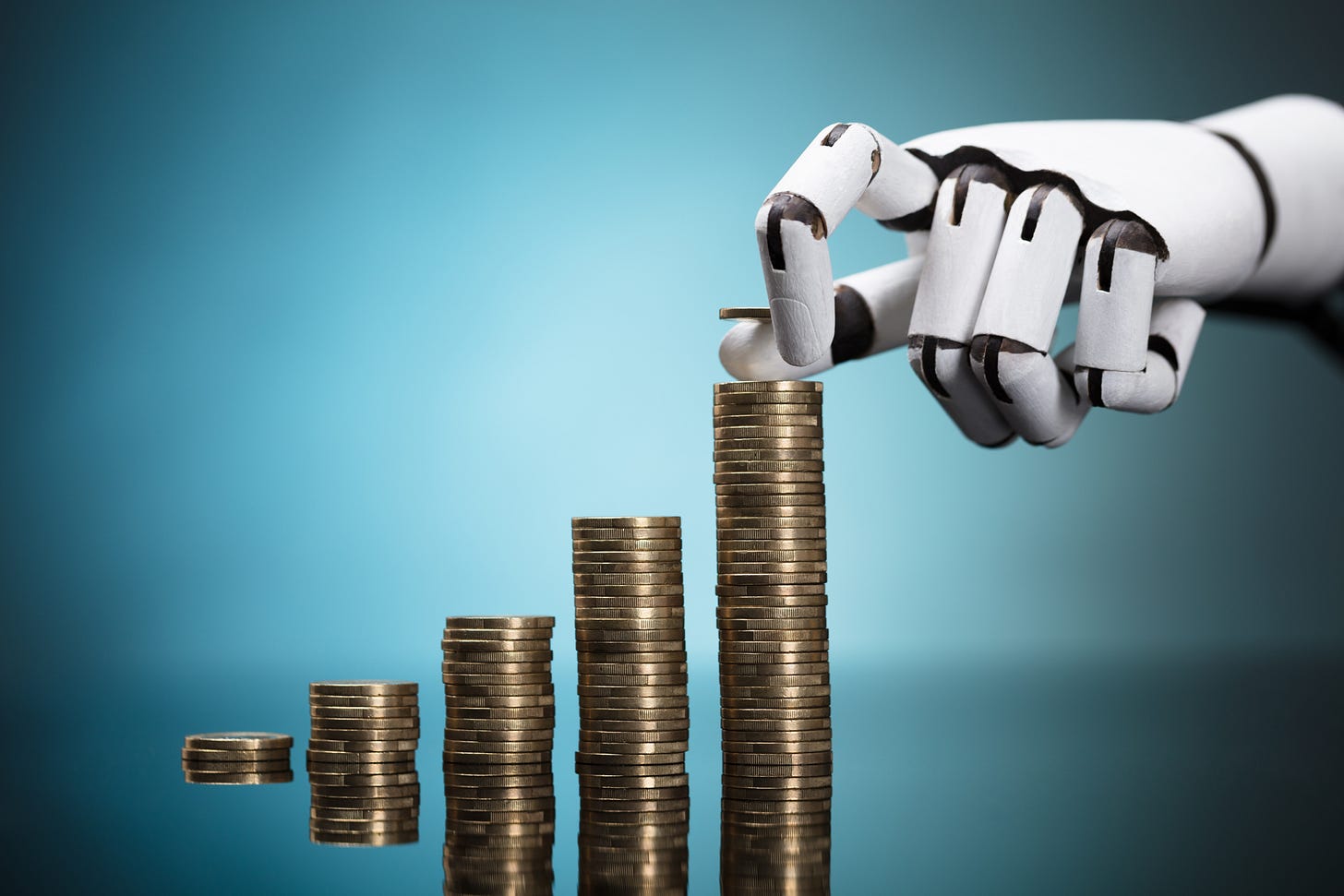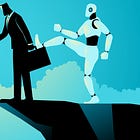Why we need to think about taxing AI
Large-scale AI-driven unemployment could hit government spending without innovative changes to the tax system
What happens to the tax system when more and more companies make moves similar to Salesforce, which this year let go of 4,000 customer support roles because of productivity benefits from AI agents? In normal conditions, those affected would generally find new work and continue paying tax, but researchers, academics, and industry players are increasingly painting a more dystopian vision of work where this may no longer be the case.
Anthropic CEO Dario Amodei told Axios in May that AI could eliminate up to 50% of entry-level office jobs within five years, potentially pushing unemployment to 10-20%, and warned that governments and industry players were “sugarcoating” what’s to come. Geoffrey Hinton, the AI researcher known as “the godfather of AI,” issued a starker warning.
“What’s actually going to happen is rich people are going to use AI to replace workers,” Hinton told the Financial Times. “It’s going to create massive unemployment and a huge rise in profits. It will make a few people much richer and most people poorer. That’s not AI’s fault, that’s the capitalist system.”
Taxing the new workforce
In a tax system which favors labor over capital, widespread workforce disruption could wipe out a significant proportion of government revenue. For the 2024/25 tax year, direct taxes on labor, in the form of income tax and national insurance contributions, made up 42% of government tax revenue in the UK, while in the US tax on workers accounted for around 84% of federal revenue, consisting of income taxes and payroll taxes.
If unemployment is pushed to 20% within five years, as Amodei predicts, then employment revenues could also be slashed by around a fifth, leaving governments in search of new ways to make up lost revenue at a time when there will be more demands on government services.
Not everyone shares this dystopian view of the future. Many tech leaders, such as Nvidia’s Jensen Huang, believe jobs will evolve rather than be eliminated. Goldman Sachs researchers estimate that unemployment will increase by half a percentage point during the AI transition period as displaced workers seek new positions, but also note that there could be a period of higher unemployment.
The uncertainty around the future of work is one of the reasons Xavier Oberson, a professor of tax law at the University of Geneva, is advocating for AI taxation.
“Can you imagine what a tax on AI, which should be a global approach, how many years it would take? I think we should really study it now,” says Oberson. He points to how long it’s taken to get global cooperation on increasing corporate tax on multinational enterprises to tackle the challenges brought by the digitization of the economy. This uses a two-pillar solution which both revises where the most profitable multinational companies are taxed, while establishing a global minimum effective corporate tax rate. An AI tax could take similarly long, he suggests, so work needs to be done now.
“And if we don’t need it because there are so many workers around, fine,” he adds.
How do you classify taxable AI?
Bill Gates brought the robot tax into mainstream consciousness in an interview with Quartz in 2017, but momentum has slowed in recent years. The robot tax refers to the taxation of companies that deploy automated technology, whether it be machines or software, to replace workers, rather than just a tax on physical robots.
Oberson was among the first academics to propose a tax on robots in the late 2010s, but he received “intense” negative reactions to his proposal. Inspired by the tax on imputed rental value in Switzerland — which homeowners pay on their own properties to create tax fairness between homeowners and renters — Oberson proposed having an imputed income applied to robots, which represents an approximation of the salary that should have been paid to human workers who have been replaced by technology.
One of the challenges, however, is clearly defining whether a “robot” is labor-replacing or simply capital-enhancing, which makes it difficult from a practical taxation standpoint, says Spencer Bastani, professor of economics at the Institute for the Evaluation of Labour Market and Educational Policies (IFAU).
There are many similarities and overlaps between the tax issues posed by such robots and those emerging around AI, says Bret Bogenschneider, a professor of accounting at Texas A&M University Kingsville. However, as society moves from having robots, which simply follow a set of instructions, to autonomous AI agents, which are not entirely controlled by those who programmed them, it could, in fact, become easier to define what type of automation should and shouldn’t be taxed.
From a practical standpoint, for AI to be taxed the AI program would, in theory, need to be assigned legal personhood, providing the AI system with a set of legal rights, the ability to sue and be sued and to be subject to taxation. Reuven Avi-Yonah, a professor of law at the University of Michigan, predicts that many technology companies will choose to put autonomous AI systems within corporate shells as a way of limiting liabilities anyway.
“Some people say, ‘science fiction!’” Oberson says. “But not really, because when you think about it, 100 years ago, in England and in the US, roughly around the same time … the concept of a legal entity became a reality under the law. But when you think about it, what is a legal entity? It’s pure fiction; it’s a creation of Congress. It’s a creation of the legislative authorities.”
Oberson views taxing these AI legal entities as a way to recoup revenue losses from worker displacement, while Avi-Yonah sees it more as a regulatory device where there could be a tax penalty, for example, if an AI hallucinates, defames or engages in racial discrimination.
“What’s nice about tax is that it can be adjusted on an ongoing basis, more easily perhaps than direct, what’s called, command and control regulation,” Avi-Yonah says.
What about capital taxes?
When it comes to simply recouping revenues, Avi-Yonah says it may just be easier to increase corporate taxes. Texas A&M’s Bogenschneider makes this case, noting that if AI becomes a larger share of the tax base, then there’s also the loss of sales tax, VAT, and property tax, all things that only humans pay, he says.
Economists look to implement taxes on labor when there is a shortfall in revenues because labor is thought to be immobile, at least compared to capital. To offset a significant decline in labor share, capital taxes would need to be raised meaningfully, says IFAU’s Bastani, but this would require global coordination; otherwise, capital would flee to other jurisdictions.
In this geopolitical environment, Bastani doesn’t see that type of global coordination materialising, but Bogenschneider argues it isn’t needed, based on his research, arguing that the high tax countries already have high economic activity and capital accumulation, while low tax rate countries have little economic activity. The driving factor is tax deductions, which reduce the taxable income multinational companies pay where they already have profits in a country. The tax system operates efficiently where it’s taxing companies that are not planning to reinvest, according to Bogenschneider. Companies that are reinvesting won’t have taxable income because profits will be offset by the tax deductions from capital investments, he adds.
Still, that doesn’t necessarily make it a politically viable proposal. An alternative put forward by Bogenschneider to the team of a US Senator who is in the final stages of making a legislative proposal for a robot tax, and wants to stay clear of corporate tax increases, involves the removal, or phasing out, of deductions on the interest a company pays when it borrows to invest in AI or robots.
Most companies borrow capital for these investments using bonds or bank loans because the interest is tax-deductible as a business expense, which brings down the income tax payable, Bogenschneider says. Reducing these deductions when the investments are being used to replace jobs with AI, in theory, could help make up at least some of the shortfall.
However, Avi-Yonah sees benefits in having a clean slate in AI taxation that isn’t bound by the weight of the last century of tax treaties, while Oberson argues that if significant disruption is on the horizon, more revolutionary approaches are required that go beyond the traditional ways of looking at the tax system.
Is it really that urgent?
Until disruption plays out in the data or there is political upheaval demanding change, immediate shifts to tax policy are unlikely to occur. There are fears around slowing adoption and hindering innovation, says Bastani. Historically, technology changes have resulted in new jobs or augmented existing ones. The Goldman Sachs researchers note that predictions that “technology will reduce the need for human labor have a long history but a poor track record.”
The baseline estimate from Goldman Sachs for job displacement from AI is 6-7%, but rates vary from 3-14% under different assumptions. The researchers have so far found “no significant statistical correlation” between AI exposure and a host of economic measures, including job growth and unemployment rates, but did highlight early signs of disruption in specific industries such as graphic design and software development.
“If I use a tool that makes me more productive and that results in a higher salary, that’s gonna result in more labor tax revenue,” Bastani says.
In a world where humans are the dominant consumers in the economy, even as AI reduces the economic role of labor, Anthropic envisions a tax on AI-generated tokens sold to end users. But the company also concedes that if we reach a stage where AI systems become major consumers of the economy’s resources, then a tax on AI resource accumulation — such as compute and other hardware — might be required.
“[These taxes] could become the only remaining mechanism to capture some of the windfall generated by AI if the role of both labor markets and human consumption in the economy declines,” the company wrote in a blog post.
Yet the complexity of creating an effective tax system for a world where AI replaces huge numbers of workers means it might be wise to start serious planning now. Michael Ahn, an associate professor of public policy and public affairs at the University of Massachusetts Boston, believes a definition for the AI industry needs to be created, and then we need to measure how much is produced, revenues reaped, and value created, before deciding on any taxation approach. But even from a preliminary analysis of industry growth, it’s clear AI will be a major determiner of the wealth of a nation, he says. While countries will want to be leaders in AI, they will also need to think about the “huge disruption” facing their citizens through displacement or augmentation.
“Do we need to do something to make this transformation a soft landing?” says Ahn. “We can have a hard landing, let it be, and then just watch everything happen, or can we do something about it to make [this] easy?”







Thank you for writing this piece.
I think one of your sources may have misled you about property taxes. "Texas A&M’s Bogenschneider makes this case, noting that if AI becomes a larger share of the tax base, then there’s also the loss of…property tax, all things that only humans pay."
But it's not true that only natural persons have to pay property tax. Corporations, LLCs, and nonprofits generally have to pay property taxes on their real estate and tangible personal property tax on their machinery and equipment. So even if mass automation causes individual humans' property holdings to collapse, it doesn't follow that property tax revenue must fall.